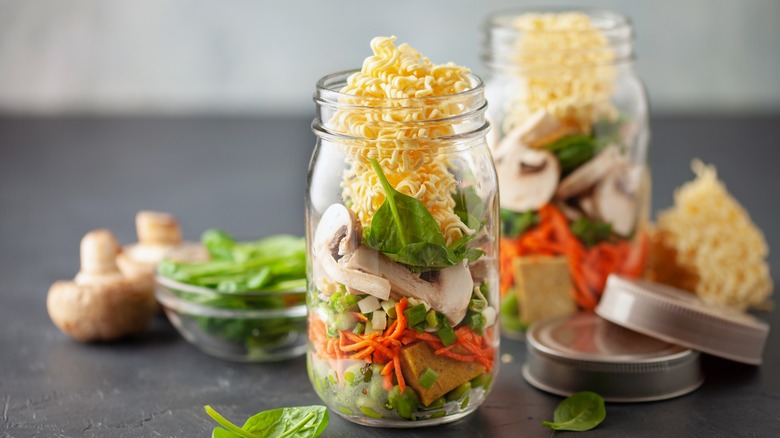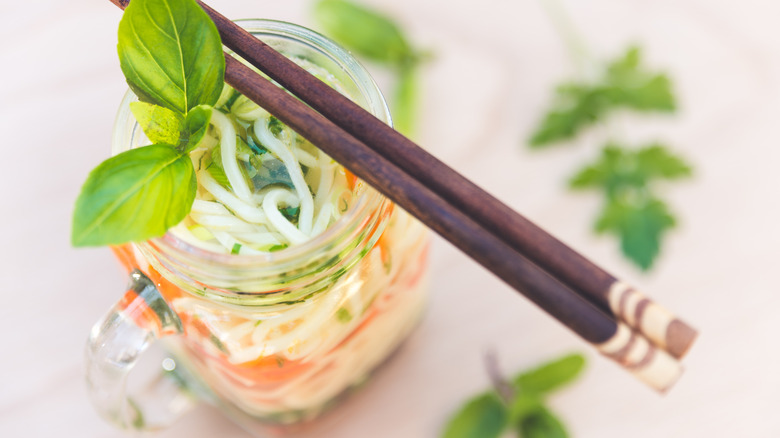Build Your Own Instant Noodle Jars For Breezy Weekday Lunches
Instant noodle jars are an excellent solution for workweek lunches or anytime meal prep. Make one to take to work for a satisfying and effortless meal, or put together a batch of them to have for whenever hunger strikes. Building your own is as easy as adding some seasonings, vegetables, proteins, and noodles into a jar and storing in the fridge until it's time to eat. Then, just add boiling water to steep the noodles ... it only takes a few minutes ... and just like that, soup's on.
Infinitely customizable, portable, and practically foolproof, instant noodle jars are a great way to get your nutrients in while taking the guesswork out of what to have for lunch. The best part is that you can make these to suit your preferences and dietary needs. Pack them with ramen or other noodles, meat or seafood, make them vegetarian or vegan, gluten-free, you name it.
The key to making these soup jars delicious is to create a flavorful broth. Choose full-bodied ingredients that, when mixed with hot water, will infuse it with umami goodness. Miso paste, soy sauce, coconut aminos, or fish sauce are all good options. Japanese Kewpie mayo gives instant ramen a flavor boost while the peanut butter broth hack gives broth an extra creamy consistency. Spice things up with sriracha, sambal oelek, gochugaru, or chili crisp. The trick is to add these wet ingredients as the first layer in the jar to prevent the other fillings from getting soggy.
How to build your instant noodle jar
Two quick options for instant soup are bouillon cubes and ramen seasoning packets. Or you could try Better Than Bouillon, which is concentrated flavor paste that comes in a variety of flavors. Additions like crushed ginger and garlic paste will help intensify the broth, and other enhancements can include tahini, coconut milk, sesame oil, kimchi, or nori strips. You can also add dried herbs and spices.
On top of your flavoring layer, you'll next add your vegetables and proteins. The sky is really the limit here. For an Asian-style soup, try shiitake mushrooms, chopped snap peas, baby bok choy, shredded Napa cabbage, and shelled edamame. Other classic fixings can include shredded carrots and purple cabbage, fresh baby spinach, julienned zucchini or cucumber, sliced red bell peppers, broccoli, bean sprouts, chopped scallions, and more. Fresh herbs such as cilantro, basil, mint, and sticks of lemongrass add invigorating flavors that help to bring everything together.
Next, add any desired proteins on top of your veggies. These can be basically anything you would normally like in a soup; just make sure to use already cooked meats as the short hot water steeping time is not sufficient to fully cook these. Try shredded chicken, sliced roast beef or steak, grilled shrimp, pork meatballs, or even hard-boiled eggs. Spam or crumbled bacon are tasty options that add tons of smokey savoriness to your soup. Cubed firm tofu is a great vegetarian alternative that's perfect for absorbing broth flavors.
Which noodles and jars work best for instant soup
Finally, you'll add the noodles. Cellophane noodles (aka Chinese glass, mungbean, or bean thread), Vietnamese rice vermicelli, and pad Thai noodles are your best bet for dried noodles that don't require pre-cooking, and these varieties are gluten-free. Unless you purchase ramen noodles that are specifically sold as "instant," ramen needs to be partially cooked before you add it to your soup jar. Prepare these per the package directions but leave about two minutes off of the suggested time. That way, once you're ready to eat them, the boiling water will complete the cooking process.
This same technique will also work well for soba, yakisoba, and udon noodles. Heartier Italian varieties of pasta like spaghetti and rotini can be cooked until al dente or even fully cooked in advance. Hot noodles should be cooled before adding them to the jar to prevent steaming the rest of the contents. When you're ready to prepare your soup, add boiling water (very hot water from a coffee maker will work too), close the lid, and wait about five minutes before opening. Give everything a thorough stir and enjoy!
As for jars, only use those designed to withstand boiling water. Mason jars and preserving or canning jars work well, but it's important to let these come to room temperature before pouring in boiling water — heat can cause cold glass straight from the refrigerator to crack. If using a microwave, remove metal lids or attachments before cooking.



